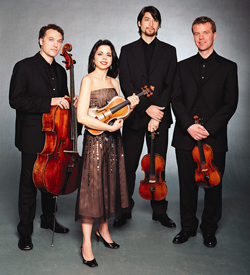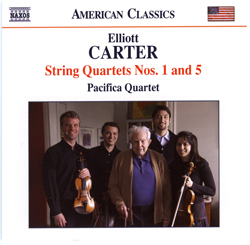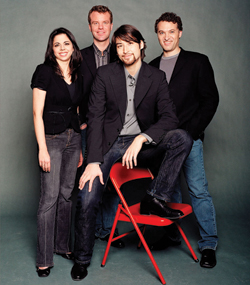On February 8, 2009, the Pacifica Quartet snared a Grammy for Best Chamber Music Performance for their Naxos recording of Elliot Carter’s first and fifth string quartets. Three days later, I was on the phone, interviewing the quartet second violinist Sibbi Bernhardsson for a series of articles.
Jason Victor Serinus: I have multiple reasons to interview you. You’re doing Mendelssohn, Brahms, and Ligeti as part of the Music at Deerfield chamber music series in Western Massachusetts; you just won the Grammy for your Carter; and you’ll be performing in Palo Alto, CA at Music at Menlo this summer for three weeks.
What is it like to go from playing Elliot Carter’s fifth or sixth quartet to Mendelssohn and Brahms? How do you negotiate moving between those different sonic universes?
Sibbi Bernhardsson: I’ll have to answer that in a couple of ways. While it’s a very sort of different language, composers all express human emotions, moods, and what they’re thinking about at any given time. It’s just that the means of it, and the language they’re using changes, just as societies change over time.
The similarity is that when we are playing Haydn, Mozart, Mendelssohn, or Carter, we are still dealing with interpretive decisions in terms of character, personality, tempi, ensemble playing, intonation, and phrasing together. The difference is that when we’re playing the music of Mendelssohn and the classical masters, so much of the attention is to play with a homogenous, group sound where the issues of blend and having a unified interpretation are paramount.
Carter, on the other hand, often asks us to be completely separate personalities. In some of his quartets, he actually assigns specific characters to each voice that we are supposed to maintain through each piece while trying not to be affected by what’s going on behind us or next to us, which of course is very tricky because we spend so much time as a quartet trying to play very much together.
The interesting thing about that is that when you come back to playing the classics, you cannot help but bring a little bit of that aspect with you. So we very much believe strongly that playing great new music helps us bring a fresh outlook to the old masters. And playing the old masters helps us play the new music better, because the attention we have to pay when we’re playing classical music works very well when applied to new music.
JVS: Last I heard the Prazak Quartet at Kohl Mansion, which is a wonderful open acoustic space where the sound is very immediate. The blend was so tight that I had trouble entering into it. If you play Carter and then go to Brahms, do you still retain the ultra-homogenous sound that I heard from the Prazaks?
SB: After Carter, you cannot help but bring the attention you pay to creating your individual character to the playing of Brahms or Mozart. We have to focus on a certain type of blend when playing the classics, but the character helps us focus a lot on creating certain types of textures and separating textures, and also maybe exploring moments where it really works to be a very cohesive quartet. Sometimes it also works to have one voice playing a little bit differently.
Also, what it has helped us in terms of balance is that instead of thinking about how certain notes have to play softer and louder, actually texturing a lot, so that while everything can be heard, you may be rhythmically profiling or bringing out your specific texture. After having done a lot of Carter, and first of all his attention to balance, which he is very, very specific about, and then also the idea of how he assigns certain personalities in the way he assigns specific intervals or specific moods, so that when has played so much Carter, when you come back you carry that approach to the older masters.
It is very helpful when you come back to a composer like Brahms, who writes so thickly. When he’s writing his string quartets, one almost feels that he has a symphonic concept. It’s very hard often to play with clarity of voices. Doing the Carter has helped us with that. We start focusing on textures: when it’s appropriate to sound incredibly blended, and when it’s appropriate not to be so blended.
There’s actually a pretty funny quote from the old Budapest Quartet. They used to say that they spent their first 20 years learning how to play perfectly together, and then spent the next 20 years learning how not to play together. [laughs]
JVS: Do you ever end performing works that you have different ideas about, and never reach a common understanding, yet it works?
SB: Sure. That’s why reason why quartets have to rehearse so much. We are four different people, but we do have to come up with a unified interpretation that is the Pacifica Quartet’s. We have to in some ways become one brain. So while we are separating textures and bringing out different personalities, we have to have a strong, unified overall concept for it to work. We have to come to a great consensus. That’s why we rehearse four to five hours a day together.
We’ve been playing together long enough to not necessarily disagree on a character or how to interpret, but we may disagree about how to get those things across. We’ll have to try all those ideas – maybe someone wants a faster vibrato, and someone wants a slower vibrato, etc. The thing is, in music and art, you cannot really compromise. The music cannot be compromised. It doesn’t work. So we have to come to a consensus, which is pretty time-consuming but very rewarding.
Sometimes we won’t come to a consensus about how to do a certain phrase. In that case, we’ll say, tonight, let’s do your idea, and tomorrow we’ll do my idea. The interesting thing is, in performance, it’s usually so obvious what works. That’s why the best rehearsal we have is often the rehearsal right after a performance. That’s when we can revisit how it felt onstage, because there’s nothing in the rehearsal room that can ever recapture performing.
JVS: Where are you now in residence?
SB: We are faculty and quartet-in-residence at the University of Illinois in Champagne-Urbana where we live. We’ve been there six years. Then we are Artists-In-Residence at the University of Chicago, and visiting performing artists at the Longy School of Music in Boston. At U of Chicago, our residency is very much performance-based. We play two recitals, coach the students, and play a lot of new music. It’s completely different from U of Ilinois, where we’re professors and teach our own students. At the Longy School of Music, we visit the schools four times a year, play a couple of concerts, and then do coachings at the school.
JVS: There’s a tendency to push interpretations to the very edge. Do you ever do that for the sake of doing it?
SB: One of the great problems for the performer is how to perform and interpret the great pieces convincingly, with a lot of thought and a lot of personality, without crossing a fine line and getting in the way of the composer. It’s a fine line between being so uninvolved with the music that it becomes boring and uninteresting. How do you interpret a piece in an exciting and interesting way that will convince the audience that it’s a great piece. It’s very challenging and tricky.
The performance has to be very honest and ethical in the interpretation. You do have a script that you have to convey. And you have to convey the composer’s intentions as convincingly as you can. It’s been really great, because we have the privilege of working with a lot of living composers when we play their music. Elliot Carter is one of them. They are often so flexible in terms of how their performances can be played, articulation markings, and dynamic markings. Things are so relative, because composers only have certain tools for marking things down. For example, a dot means separation, but it’s up to decide how separate, for how long, how detached, etc.
When we play something by a great master such as Beethoven, there’s a temptation to become a prisoner to what’s on the page. While you have to completely try to follow the script as sincerely as possible, you also have to find a way that sounds good and is convincing.
JVS: I assume with Ligeti, there aren’t many controversies over whether what’s in the printed score is what he wrote down or what the publisher either inserted or copied incorrectly. But with Mendelssohn and Brahms, how sure are we that we the markings we see are the markings they wrote?
SB: This is a difficult question. Even in the case of Beethoven, where you may have copies of the original manuscript, you also have scores of the first published editions which were corrected by Beethoven and are different from the original manuscript. Which do you go by?
In the case of Shostakovich, for example, he wrote specific metronome markings, but then did not follow them whatsoever when he performed and recorded. We don’t know if he adjusted for the performer he was playing with or the hall. It’s hard to lock yourself into those things. But you have to try the markings with sincerity. What we find is that with a composer as great as Beethoven, if you follow his markings, it usually works really, really well.
JVS: Terry Riley told me that after he wrote performing instructions in the score of In C, he’d work with a new ensemble and discover them protesting when he played it differently than he had indicated. So Terry removed the directions, since they were only meant as guidelines for people who hadn’t played it before.
You all look like babies. Yet you’ve been together 14 years. How old were you when you first got together?
SB: We knew each other and were friends even before we became a quartet. I came here to study at Oberlin Conservatory, which Simin and I both attended. But we met even before that. Our violin teachers are a couple, Roland and Almita Vamos, and they happen to be our cellist Brandon’s parents. I had come from Iceland, and she from LA, and through them we met their son Brandon. We were playing together in summer music festivals when we were teenagers.
Masumi and I also met at a summer music festival. He’s born and raised in New York, and went to school there. We were randomly put together in a string quartet at the Norfolk Chamber Music Festival, and liked playing together. So that’s how he came into the group.
We are very blessed to get along very well as a quartet. One reason is that we were friends before we became colleagues. There’s an underlying friendship and respect that keeps us together through the heat of rehearsal.
JVS: At Smith College, you’ll be playing Mendelssohn’s String Quartet Op. 44, No. 1. What do you have to say about the piece?
SB: It’s a great example of Mendelssohn at his best. It’s incredibly brilliant writing, exuberant and optimistic. He’s such a master of textures. The way he writes, everything works, everything is right. His harmonies are correct, and his modulations seem as though they cannot be any other way.
JVS: You’ll also be playing Ligeti’s first string quartet.
SB: Ligeti is arguably the greatest 20th century composer. He’s definitely in the top five.
JVS: How can you argue that he’s greater than Shostakovich or Bartók? How do you support that statement?
SB: Maybe I shouldn’t say ‘the greatest.’ He’s arguably one of the greatest, and certainly one of my favorite composers. His music is incredibly expressive, honest, and exciting. He writes incredibly well for the instruments, and it’s such interesting writing. His sound world is spectacular. When you listen to Ligeti, there’s no question that it’s him, because he doesn’t sound like any other composer. His early stuff sounds similar to Bartók, who greatly influenced him, but he changed very much later on. It’s incredibly exciting, and for lack of a better word, accessible music. It’s not a coincidence that Stanley Kubrick used his music as a soundtrack for so many movies, because the music speaks so directly to you.
The way he uses rhythm is very effective. His harmonies are very dissonant, but they sound lush (if that makes sense). It’s really exciting writing, extremely emotional and expressive. He writes so well for the instruments, and has great control of his compositional technique.
JVS: Had he found his own voice at the time he wrote No. 1?
SB: A little bit. His No. 1 is sometimes jokingly referred to as Bartók’s Seventh String Quartet. He wrote it in the ‘50s, and you can hear Bartók’s influence in certain folk elements and parallel fifths. But there’s no question that it’s Ligeti, because his harmonies are so different, and his rhythmic use is very different.
JVS: You’re also playing Brahms’ Op. 51, No. 2. How do you describe the glories of Brahms?
SB: He’s obviously one of the great, great, great masters, and one of my favorite composers. There are so many things that make his great. He doesn’t write per se interesting melodies, but the harmonies are so lush. The rhythms, textures, and craftsmanship are so masterful. That is what makes his music so expressive. His sound world is so warm, so lush, and so nostalgic. He covers the whole range of human emotions. It’s very difficult to criticize Brahms in any way.
JVS: And he destroyed so much music…
SB: so that only the good stuff was left.
As a performer, what’s hard about Brahms is that his concepts are so grand that I feel like, when he’s writing for a strong quartet, it seems like he has a symphonic concept. Balancing the music, and bringing out the voices and the clarity of lines is a great challenge. It’s hard, but it’s worth it.
In his writing, he often has instruments in similar registers that make the clarity of voices complicated. But if it’s done correctly, the result is very satisfying.
Op. 51, No. 2 represents Brahms at his best. He uses a four-note motive with the written inscription, ‘free but lonely.’ It sets the tone for the whole piece, because it’s very expressive in a rather introverted and private way. It’s beautiful, often nostalgic, and in typical Brahmsian fashion often smiling through the tears. But it’s so well written, the harmonies are lush and rich, and the harmonies just feel right. They feel good. It’s one of the great, great quartets of the literature.
JVS: What will you be doing at Music at Menlo?
SB: We’re doing a Mendelssohn cycle that will feature all of his quartets and his octet. There may be a couple of mixed ensemble things thrown in. That’s four concerts in 10 days to two weeks. We start on July 20 and perform through August 8. Then we perform at Music in the Vineyard.
JVS: I know you’ve got a student waiting for you outside the door. Hopefully we can speak again before the summer, and I can find a way to preview your performances at Music at Menlo.
Pacifica Quartet
http://www.pacificaquartet.com/
Jason Victor Serinus





